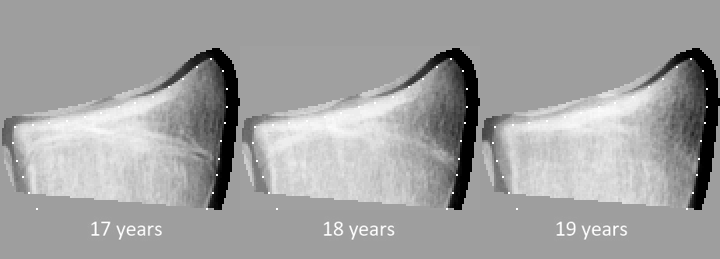
Automated bone age extended up to 19 years
The upcoming release of BoneXpert version 2.4 (version 2.4.5.1, released Dec 28) extends the Greulich-Pyle bone age range up to 19 years for boys and 18 years for girls. Previous versions were less reliable in the bone age range 17-19 for boys and 15-18 for girls. The validation of this extension is reported in the International Journal of Legal Medicine.
To determine bone ages above 17 in boys and above 15 in girls – the so-called end-of-puberty range – is extra challenging, because the short bones show no sign of maturation in this range, so the assessment must be based solely on radius and ulna – and at the very end on radius alone. More advanced image analysis methods were therefore introduced to ensure that the analysis is reliable. The development benefited from the Zurich Longitudinal Study of 231 healthy children followed with annual X-rays until age 20 – the images above show the radius of a boy at bone ages 17, 18 and 19 years.
The paper presents validation studies from Los Angeles and Rotterdam showing that BoneXpert’s agreement with manual rating in the end of puberty range is as good as at lower bone ages.
The use of bone age for assessment of the age of asylum seekers will be the topic of a “Special focus session” at the European Congress of Radiology in Vienna in March 2017. The session is organised by Karen Rosendahl from Bergen, Norway, and H H Thodberg is an invited speaker. The new paper in International Journal of Legal Medicine addresses this issue with a probabilistic framework for age estimation and the analysis is based on the Zurich Longitudinal Study, which is representative of modern European Caucasian children. If one classifies males as “adults”, if the bone age is above 18.2 years, the accuracy of the automated method is the following (validated only for Caucasian Europeans)
- 10% of children of age 15-17.99 years are wrongly classified as adults (the false positive rate)
- 30% of adults of age 18.0-20.99 years are wrongly classified as children (the false negative rate)
